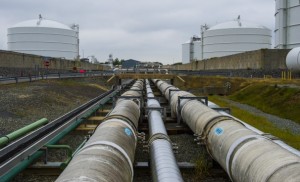The U.S. oil and gas boom is straining the country’s infrastructure
By Brad Plumer, Published: July 18 at 12:07 pm
Over the past few years, the U.S. fracking boom has taken a great many people by surprise. Companies have been producing so much oil and gas that it’s now putting a strain on America’s energy infrastructure.
Case in point: The Energy Information Administration recently put out a report showing that U.S. transport of crude oil by rail, truck, and barge has soared by 57 percent between 2011 and 2012, surpassing 1 million barrels per day.
Out in North Dakota, for instance, companies are now producing far more shale oil from the Bakken formation than existing pipelines can handle. So the producers are instead shipping it by rail to the refineries that will turn it into gasoline and other fuel. Here’s a chart showing the surge:
And there’s a downside to this shift. As more and more crude oil gets transported by rail, that means a greater risk of rail accidents and spills.
Mike Soraghan has a nice piece in Energywire today on that trend, noting that “spills and other accidents from railroad cars carrying crude oil has skyrocketed in recent years, up from one or two a year early in the previous decade to 88 last year.” Here’s the chart:
This phenomenon isn’t limited to the United States, either. Canada has also seen a big leap in rail shipments as oil-sands production in Alberta expands rapidly. Earlier this month in Quebec, a train carrying 72 cars of crude exploded in the town of Lac-Mégantic, killing at least 37 people. As my colleague Steve Mufson reported, that accident sharpened the debate over the construction of controversial new oil pipelines like Keystone XL.
On the one hand, climate activists can argue that the dangers of rail make it a less viable alternative and strengthen their argument that denying a permit for Keystone could stop some oil-sands development.
On the other hand, if rail developments proceed despite a heightened sense of danger, then pipeline supporters can argue that pipelines are safer.
But it’s worth emphasizing that there’s much more than rail safety and Keystone XL to consider. In the most recent issue of Democracy, former White House energy adviser Jason Bordoff makes an extended argument that North America’s energy infrastructure has yet to catch up with growing oil and gas production in all sorts of ways.
For instance, nearly one-third of the natural gas that’s produced in North Dakota is simply burned off, or “flared,” because there are no pipelines to bring it to market. (Unlike crude oil, natural gas usually can’t be shipped by truck or rail.) That explains why you can see the Bakken fields lit up from space, and it’s not ideal from either an economic or an environmental perspective:
Without changes, those pipeline bottlenecks for natural gas could get tighter in the years ahead. ”The National Petroleum Council estimates 30,000 miles of new long-distance natural gas pipelines will be needed to manage the new sources of supply,” Bordoff notes. “[I]t takes the Federal Energy Regulatory Commission (FERC) an average of 18 months to permit an interstate natural gas pipeline—which is relatively quick compared to some other pieces of large infrastructure.”
In his piece, Bordoff offers a slew of recommendations for updating America’s energy infrastructure: He argues that there are ways to speed up the permitting of domestic pipelines and to reduce the amount of flaring. He laments that the Jones Act puts restrictions on domestic seaborne transport of petroleum between U.S. ports. And he suggests that the federal government needs to conduct a review of rail safety.
The piece also takes time to stress the need to tackle climate change, and Bordoff wonders if there’s a deal to be made here between environmentalists and industry (while noting that there “is good reason to be skeptical about the prospects for such a deal”):
The energy grand bargain we need is simple: Government must take steps that help the oil and gas industry develop America’s newfound abundance even more quickly—on permitting, exports, the Jones Act, clear and sensible fracking safety regulations, and other issues—while industry works with government on longer-term actions to meaningfully reduce carbon emissions. […]
To realize the benefits of this changed energy landscape, our energy infrastructure and regulatory structure need to be updated to reflect the new reality. Yet while hydrocarbons are going to remain a central part of our energy mix for decades, the prospect of displacing them with alternatives—in our power plants, our cars, our industries, and elsewhere—has never been a more viable option and, indeed, a more urgent necessity.
Not everyone will agree with these recommendations, obviously — or the bargain. But his essay offers an excellent overview of the ways that America’s infrastructure is out of sync with recent energy developments.
_____
Taken from The Washington Post: http://www.washingtonpost.com/blogs/wonkblog/wp/2013/07/18/the-u-s-oil-and-gas-boom-is-straining-the-countrys-infrastructure/





Pingback: The U.S. oil and gas boom is straining the country’s infrastructure | Construction AccidentConstruction Accident
Pingback: How can gas prices be slashed? Repeal this act | Family Survival Protocol - Microcosm News